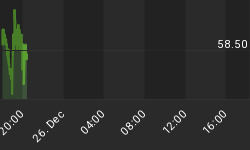Perhaps the most interesting development during the intensification of the credit crisis is that the price of gold did not climb higher than it did. Upon the initiation of the crisis in August 2007, the price of gold surged reaching a high of $1002.95 on March 14, 2007. Since then the cost of the precious commodity has fluctuated with the most recent price action sending it to recent lows of 725.74. However, given the pervasive uncertainty in markets we think that this represents a strategic buying opportunity on the back of our bullish call for gold to spike towards $1100 in 2009 with the potential for a much larger move over the longer term.

Given the sheer volume of liquidity that has been pumped into the global economic system over the past year it is an understatement to say the least that the price of gold has trended downward. A look at the adjusted money base of the US indicates that the money supply is up 18.6% year over year. The Fed alone has pumped over 1 trillion dollars into the economy and the US federal government will do well to avoid running a 2 trillion dollar deficit during fiscal year 2009.
The enormity of the steps taken to prevent a complete meltdown of the global banking system will put at risk years of hard won credibility of global central banks and keep the specter of inflation at the forefront of the minds of the investing class. Although, we are currently poised to observe a dis-inflationary moment as the deleveraging that is already underway has ushered in a period of intense declines in the values of assets across just about every class. With the velocity of money in decline, the contemporaneous increase in the supply of money should not stimulate an increase in inflation in the near term. However, over the longer term the independence of the central banks around the world will be severely tested by governments and publics beset by extraordinary levels of debt and increasing rates of unemployment.

Moreover, the increase in the supply of gold will fall well short of the increase in the supply of paper money over the next few years. In the context of a profound economic uncertainty, financial instability and geopolitical turbulence gold will slowly begin to reassert itself as the preferred safe haven of savvy investors, probably at the expense of the US dollar.
The risks to this scenario are two fold. First, the current dis-inflationary moment quickly unwinds and evolves into a Japanese style deflation for the US and the major economic powers, which would depress the price of commodities further and limit the upside on gold. Second, that the financial stress in the EU, Asia and emerging markets could turn out to be more pronounced than that of the US. This could cause the dollar to continue to appreciate, which would limit the upside of the move in the price of gold.

Given the volatility in the price of equities and the uncertainty in fixed income markets over the intent of the Federal Reserve at this time, we are much more confident in the direction of the price of gold over the medium term than we are that of stocks and treasuries. The steps taken by global central banks have begun to thaw credit markets and interbank lending appears to be in the process of recovering. But those, steps may be difficult to reverse and increase in dollar denominate reserves we think is a bullish signal on gold going forward.
The unwinding of positions in a panic and the intense period of deleveraging ahead has stimulated many market participants to move smartly into Yen and quite interestingly, into the dollar as a safe haven moves. Given the stability of the Japanese banking system, the move into the Yen makes sense. However, we see the recent strength of the dollar an understandably reactionary move by global investors after a half-century of a dollar hegemony, to find shelter in a global storm where no safe havens appear to exist and instead have turned to a deeply indebted US government out of habit. Thus, once the tide begins to ebb from the storm and investors can begin to evaluate the extent to which the US, EU and global governments have moved to stem the tide we do expect that gold will replace the dollar as the preferred hedge against uncertainty ahead.















